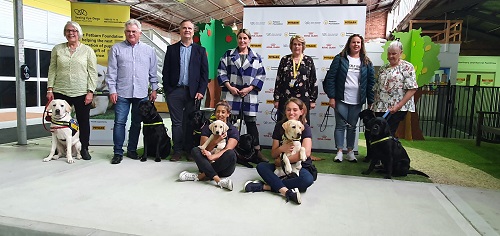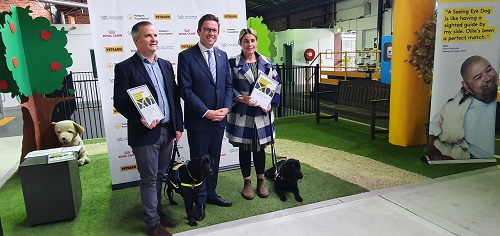Throughout this global health pandemic, we’ve all learned what it’s like to be denied our freedom of movement, social inclusion, or easy access to what we want or need.
Imagine how it feels then for people who are blind or have low vision, and who rely on Seeing Eye Dogs to achieve these same simple aims, to be denied a place in public spaces.
It’s not only frustrating, it’s unlawful.
Seeing Eye Dogs are essential companions for people who are blind or have low vision, supporting them to fully participate in public life.
Today, another 48 of these trusted companions were recognised at the 2022 Seeing Eye Dog Graduation event, coinciding with International Guide Dog Day.
From teenagers, through to people in their 80s', these 48 Seeing Eye Dogs are supporting people who are blind or have low vision across Australia.

Caption: Seeing Eye Dogs recognised nearly 50 new handlers on International Guide Dog Day.
People like Ollie Fanshawe, who at age 14, became Vision Australia’s youngest-ever Seeing Eye Dog handler. Historically, handlers are aged 18 and up.
Ollie was born blind and long yearned for his own Seeing Eye Dog. His family helped ready him for the responsibility by adopting a rescue Labrador he could learn to look after.
The experience of walking, feeding and playing with his pet helped enhance Ollie’s orientation and mobility skills, and soon matched him with Seeing Eye Dog Sadie.
Sadie has lifted Ollie’s spirits and led him to discover a life that other teens might take for granted; navigating the school yard, running errands, or catching transport.
In time, Sadie will help Ollie overcome the obstacles of adulthood, just as Eva does for Chris Edwards, Vision Australia’s government relations and advocacy manager.
Chris’s career, and his passion for adventure, makes him a regular traveller across Australia, having clocked up more than 100,000 kilometres in the past decade.
Chris said that Seeing Eye Dog Eva is “the one that enables me to be independent and provide the confidence I need to live the life I choose”.
Eva first flew with Chris last year. Airports can be a challenging environment for everyone: big terminals, tight security, and looping luggage carousels.
But Chris said that “having a dog that’s so well trained [to] get through … and be able to feel confident that they’re doing the right thing … is such a special thing.”

Caption: Chris Edwards with Seeing Eye Dog Eva, Honourable Minister for Child Protection and Family Services and Minister for Disability, Ageing and Carers Anthony Carbines MP and Olivia Penna with Seeing Eye Dog Astra.
Airports and airplanes are just two of many public places or facilities that Seeing Eye Dogs and their handlers can lawfully access in every Australian state and territory.
While legislation may be worded differently across the nation, the intent is the same: that assistance animals and handlers have equal rights of access as do all citizens.
Despite these laws and his own credentials, Chris has often been denied access to restaurants, ride-shares, and more, which is “embarrassing – and discriminatory”.
On International Guide Dog Day, Vision Australia continues to advocate for greater community awareness about access rights for Seeing Eye Dogs and their handlers.
Chris said, “The more understanding we have of this, the closer we’ll be to creating an inclusive society for people who are blind or have low vision.”

